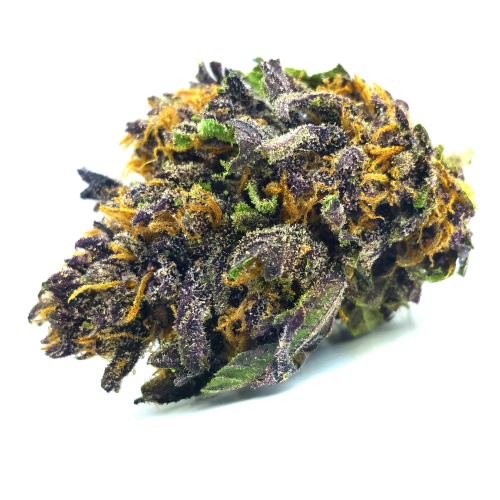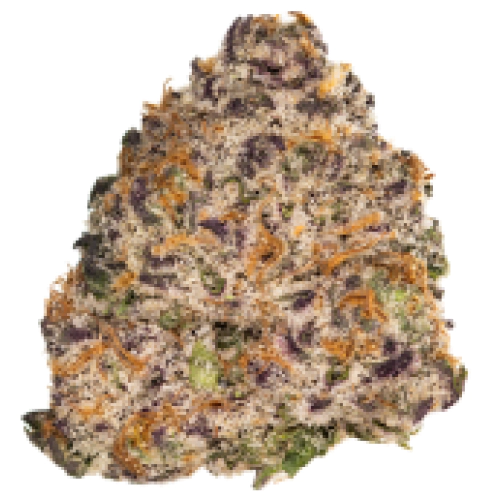THC 17 - 24%
CBD 1.16 - 1.38%
Effect Giggly
Flavor Lemon
20 - 22%
0.8 - 1.1%
0.04 - 0.14%
Pungent, Tar
Relaxed
The Grape Cola strain holds 90% Indica and 10% Sativa genes. The THC level is 20-22 percent, and the CBD content is 0.8-1.1 percent. The cannabinoid profile of this cannabis is bountiful and includes the following chemical compounds:
The plant’s terpene composition is rich, with limonene and linalool found in excess. These compounds determine the aromatic characteristics of the strain. Grape Cola features a strong, pungent smell, creating a bubbly feeling in the mouth. It reminds smokers of drinking a fizzy cola beverage. The kush is typically consumed through a glass pipe or a vaporizer for optimal taste.
Although this weed does have prevalent Sativa genetics, users don’t experience much in the way of energy during the high. Instead, relaxation comes in quickly, leaving people to calm their racing thoughts.
The Grape Cola strain's soothing effects have several applications for medical marijuana patients. Its ability to improve mood can alleviate the symptoms of stress and anxiety. Also, it dulls physical pain, which is caused even by chronic conditions like arthritis and muscle spasms. The strain is also beneficial for its anti-inflammatory properties. It is a good munchie herb that helps patients with a lack of appetite.
The Grape Cola strain is an excellent choice for people with low THC tolerance since it doesn’t cause severe adverse effects. The most common reactions include:
Individuals who smoke this kush for their health concerns should be careful about the dose to avoid unpleasant reactions.
The Grape Cola strain is not difficult to cultivate. The shrubs don’t require extra support for branches since they reach only 30-60 inches in height. This pot does best inside and outside and takes only 52-62 days to flower and fully mature. In 61 days, the plants are ready to yield. The indoor harvest amounts to 1-2 oz./ft2, and outdoor returns can be 10-15 oz./plant.
| THC | Tetrahydrocannabinol, or THC, is a major cannabis chemical compound. It is a psychoactive element that stimulates dopamine release and induces euphoria or happiness. THC-rich strains may be helpful with such conditions as lack of appetite, chronic pains , etc. It is considered to be the primary active marijuana component. | 20 - 22% |
| CBD | Cannabidiol, or CBD, is a major compound in cannabis, which is non-psychoactive. It is also proved to counteract the side effects of the second major component THC. CBD is widely used for medicinal purposes in rubs, oils and so on. It is helpful in muscle pain cases, may treat arthritis and migraines. Even Greeks used it against pain, while Queen Victoria applied it to get rid of menstrual cramps. | 0.8 - 1.1% |
| CBC | Cannabichromene, or CBC, is a minor cannabinoid, meaning that its quantity in cannabis is quite little. Though it has the same origin as CBD and THC, it is different in functions. Without any psychoactive effects, it is an efficient cannabis compound in combating acne and depression. CBC produces analgesic, antibacterial and anti-inflammatory effects. | 0.25 - 0.32% |
| CBG | Cannabigerol, or CBG, is one of the minor cannabis compounds in adult plants. On the other hand, young ones contain a lot of this antibacterial and anti-inflammatory component. During the growth, CBG is converted into different cannabinoids, mostly THC and CBD. The compound itself increases appetite and decreases eye pressure. | 0.04 - 0.14% |
| CBN | Cannabinol, or CBN, is a trace element in cannabis that is considered to be mildly psychoactive. It appears from oxidation THC, exposed to light and heat. CBN is mostly contained in old cannabis and in traditional hashish. It is effective against insomnia, bacterial infections and appetite loss. | 0.03 - 0.24% |
| THCV | Tetrahydrocannabivarin, or THC-V, is a compound contained in cannabis in trace amounts. Even though it is close to THC molecularly, it is different in effects. This compound may be psychoactive only in large amounts. THC-V reduces blood sugar, controls appetite, stimulates bone growth, etc. African Sativa strains are the richest in THC-V. | 0.19 - 0.39% |
| Carene | Carene (also known as Delta-3 carene) is a terpene found in rosemary, lemons, pines, and cedars, offering citrusy and cypress aroma. Studies on mice showed that carene provides anti-inflammatory effects, as well as promotes bone health and chronic pain relief. | 0.19% |
| Myrcene | Myrcene (also known as β-myrcene) is one of the most common terpenes found in cannabis, representing more than 20% of the modern marijuana terpene profile. Myrcene has a distinct earthy, musky flavor, resembling cloves. It is responsible for calming and soothing effects of weed. Myrcene is also found in hops, thyme, mango, lemongrass, guava melon. | 0.19% |
| Camphene | Camphene is terpene common for carrots, pepper, dill, fennel, nutmeg, thyme, as well as other fruits and vegetables. Camphene has a damp, pungent, herbal, minty aroma with pine undertones. In cannabis, mostly found in Indica strains. Camphene causes cooling sensations, having anti-inflammatory, antibiotic, antioxidant, analgesic, and antifungal effects. | 0.01% |
| Humulene | Humulene (also known as α-humulene) is one of the major terpenes found in cannabis, contributing to woody, earthy, spicy, herbaceous, and, mainly, floral aromas of cannabis. Used in modern medicine, humulene offers anti-inflammatory, antibacterial, and appetite suppressant effects, which have been well-researched by pharmaceutical companies. | 0.04% |
| Limonene | Limonene (also known as d-limonene) is the second most common terpene in nature and the third most common terpene in cannabis. It has a powerful citrus aroma and can be found in all citruses, including lemons, oranges, grapefruits, limes, juniper, etc. Limonene is known to elevate moods and provide anxiety, depression, and stress relief. | 0.29% |
| Linalool | Linalool (also known as beta linalool, linalyl alcohol, linaloyl oxide, and p-linalool) is one of the rarest terpenes found in cannabis, mostly in small quantities. Linalool is known for its spicy and lavender aroma, bringing relaxation and calming effects. It is also said to provide anti-inflammatory and analgesic properties that can be useful for athletes. | 0.24% |
| Terpinolene | Terpinolene is one of the most common terpenes found in cannabis; however, It's usually presented in small quantities. Is responsible for piney, floral, herbaceous, and even a little bit citrusy aroma of cannabis. Terpinolene can be found in lilacs, nutmeg, and cumin. In cannabis, terpinolene contributes to the sensation of "freshness." Has the potential to reduce the risk of heart diseases. | 0.03% |
| Total terpenes content | 0.99% |
THC 17 - 24%
CBD 1.16 - 1.38%
Effect Giggly
Flavor Lemon
THC 20.25 - 19%
CBD 5.95 - 7.39%
Effect Sleepy
Flavor Sweet

THC 21 - 24%
CBD 0.69 - 1.13%
Effect Tingly
Flavor Chestnut
THC 22 - 23.5%
CBD 0.14 - 0.52%
Effect Relaxed
Flavor Citrus
THC 10.11 - 16.02%
CBD 0.1 - 0.96%
Effect Euphoric
Flavor Diesel
THC 20.25 - 22.75%
CBD 0.62 - 0.83%
Effect Sleepy
Flavor Spicyherbal

THC 19.25 - 21.25%
CBD 0.44 - 0.86%
Effect Sleepy
Flavor Pine
THC 18 - 23%
CBD 0.74 - 0.68%
Effect Giggly
Flavor Spicyherbal
THC 22 - 23%
CBD 0.59 - 0.84%
Effect Happy
Flavor Tar
THC 11.5 - 16.5%
CBD 0.08 - 0.6%
Effect Tingly
Flavor Grape
THC 18 - 22%
CBD 0.97 - 1.09%
Effect Happy
Flavor Grape
THC 12 - 13%
CBD 0.24 - 0.4%
Effect Aroused
Flavor Chemical
THC 11.19 - 15.25%
CBD 0.4 - 1.22%
Effect Giggly
Flavor Plum
THC 18 - 22.5%
CBD 0.08 - 0.8%
Effect Happy
Flavor Spicyherbal
THC 17 - 17%
CBD 0.1 - 0.3%
Effect Sleepy
Flavor Grapefruit
THC 13.35 - 15.28%
CBD 0.02 - 0.29%
Effect Tingly
Flavor Pine
THC 16.75 - 19.5%
CBD 0.61 - 0.9%
Effect Sleepy
Flavor Sweet
Be the first and share your opinion
Write a Review